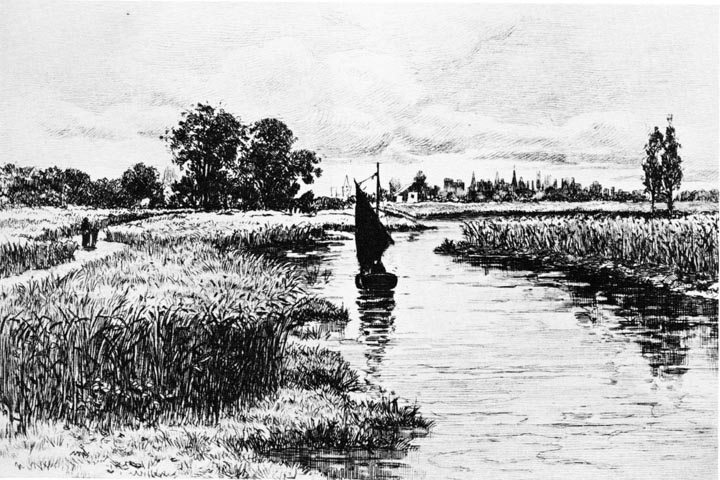
The Lady of Shalott by Jas. Fagan (dates unknown). Published in One Hundred Illustrations to Tennyson (1895). India proof of etching on paper mounted on heavier paper, 3 1/2 x 5 1/2 in. (9 x 13.8 cm.). Unsigned. The John Hay Library, Brown University. Scanned image and formatting by by George P. Landow. Commentary by Timothy R. Rodgers:
One Hundred Illustrations to Tennyson, an unbound portfolio of etchings, photoetchings, mezzotints, and photogravures illustrating Tennyson's poetry, evidences the popularity it achieved during the last half of the nineteenth century. One hundred sets of these portfolios were published in 1895 for the wealthy collector or the dedicated Tennyson enthusiast. One of Tennyson's earliest and most popular poems, "The Lady of Shalott," was illustrated in the portfolio by Jas. Fagan, who indicated in the table of contents his intention to illustrate the lines "On either side the river lie/ Long fields of barley and rye." However, the focus of the image, a dark boat floating down the river to Camelot, signifies that the illustrator might have either portrayed the dead Lady floating down the river to Camelot or else foreshadowed her eventual journey to Camelot. Fagan depicts the scene at midday whereas the poem states that the Lady of Shalott leaves her tower and launches her boat at dusk. Thus, the illustration probably foreshadows the end of the poem instead of literally representing it. To underscore his attempt to predict her death, Fagan does not utilize conventional modeling for the sailboat, which appears a black silhouette accented by the afternoon light. The small black sailboat contrasts dramatically with the beautiful bright sun reflecting off the fields of wheat and barley and off the glimmering buildings of Camelot. The sailboat thus symbolically contrasts the shadowed, impending mortality of the Lady of Shalott with the radiant, carefree lives of those who live in Camelot.
Tennyson's use of sparse descriptions in "The Lady of Shalott," which do not limit the artist's imagination, made the poem a delight to illustrate. The poem presented Fagan with a chance to emphasize his abilities as a landscape artist without neglecting his obligations as an illustrator. For American artists the opportunity to depict landscapes rather than Gothic, medieval, or legendary European subjects allowed them to maintain a connection with the Pre-Raphaelite movement without avoiding or abandoning the American cultural context in which they worked.
Bibliography
Rodgers, Timothy R. Ladies of Shalott: A Victorian Masterpiece and its Contexts. Ed. George P. Landow. Brown University: 1985. p. 136.
Fagan, Jas. One Hundred Illustrations to Tennyson. Boston: Estes and Lauriat, 1895.
Last modified 30 December 2006